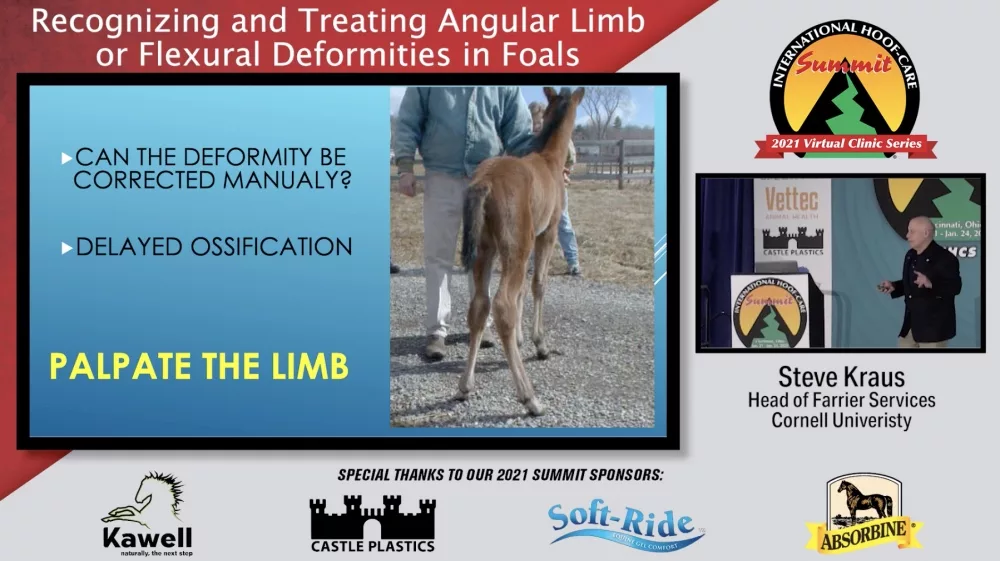A farrier can count on two things when working on foals with angular or flexural deformities — the experience will be frustrating, yet rewarding, experience.
“It’s frustrating because, as one of my students said, you have to put your patience pants on,” Steve Kraus, the head of Farrier Services and senior lecturer at Cornell University, tells attendees during his International Hoof-Care Summit — 2021 Virtual Clinic Series presentation “Recognizing and Treating Angular Limb or Flexural Deformities in Foals.” “It’s rewarding when you make a difference. In some cases, you’re saving a horse’s life. It’s rewarding when the horse owner comes back several years down the road and tells you, ‘If it wasn’t for what you did, this horse wouldn’t have made it as well as it did.’”
Before joining Cornell, Kraus worked on a variety of horses in his private hoof-care practice in Upstate New York. Although horse owners had foals, they didn’t call Kraus to work on them until they’re a year or 2.
“By then, they’re trying to kick the crap out of us,” he says. “I don’t want to work on babies.”
Kraus’ opinion change in the late 1980s and early ’90s when he was hired by John Valentino to work on the foals of his large Thoroughbred farm. A self-made millionaire who was accustomed to having things done his way, Valentino wanted Kraus to see the foals within a week to 10 days after they were born. He wanted Kraus to carefully observe them, have them walk to and away from him, take photos and keep meticulous records.
“As a younger farrier, I was thinking that I can do this without that crap,” Kraus recalls. “But, I did it because if I’m going to work for somebody, I’m going to give them 100%. Sure enough, it made a difference in our objectivity about these horses and how to keep track of things. We were trimming these horses every 3 weeks. We had straight-legged horses and no need for any kind of surgery. I learned a lot from John Valentino and he had some top money-earning horses — some of the top racing horses in New York State in the early ’90s.”
Angular Vs. Rotational Deformities
When observing the foal with a deformity, it must be determined whether it is angular or rotational.
“That’s one thing that we have to really figure out because the treatments are different,” Kraus says. “You also have to recognize what flexural deformities are and why they are there. This goes into whether we want more exercise or less exercise, aside from what we do.”
An angular limb deformity is an angulation at the joint, typically varus (medial) or valgus (lateral).
“People confuse these terms all the time,” he says. “The best way to remember that a valgus deformity is lateral is that it is spelled with an L. L for lateral.”
A rotation deformity is a malformation of the hoof in relation to the limb axis. In other words, it’s twisted in one way or another.
When examining a foal to determine whether it has an angular or rotational limb deformity, a farrier should observe it from the front.
“If a deformity is present, you need to align yourself not with the horse’s chest but the foot,” Kraus says. “If you get in front of the foot, you can see if it’s an angular or a rotational deformity. You can also lift the limb and let the front limb hang straight down and see if it is going this way or that way. You can also see if you can manually correct it. Don’t force it on a young horse.”
When you observe a hind leg, a farrier can pick up the limb and get behind the hock.
“It’s almost like shooting a shotgun,” he says. “You need to have your face back on the stock and look down the barrel to line things up.”
It’s also important to watch the foal walk toward and away from you, as well as examine the feet.
“Foals are pretty much born with symmetrical feet but if there’s any type of angulation or problem, the feet are going to start distorting,” Kraus says. “They’re very sensitive and they’re growing very fast. You can look at the feet and how you trim and see what’s not symmetrical at this point.”
Gain more insight on limb deformities and how to treat them by watching Kraus’ International Hoof-Care Summit — 2021 Virtual Clinic Series presentation “Recognizing and Treating Angular Limb or Flexural Deformities in Foals.”
If you’re not registered for the International Hoof-Care Summit — 2021 Virtual Clinic Series and would like to watch Kraus’ presentation or the 17 other informative Therapeutic Shoeing sessions in February, you can do so here. Each month, the IHCS will tackle a different hoof-care theme. Register today to access February’s sessions, as well as those that follow through September. In addition, you will be automatically signed up to attend live online panel discussions, as well as live question-and-answer sessions.







